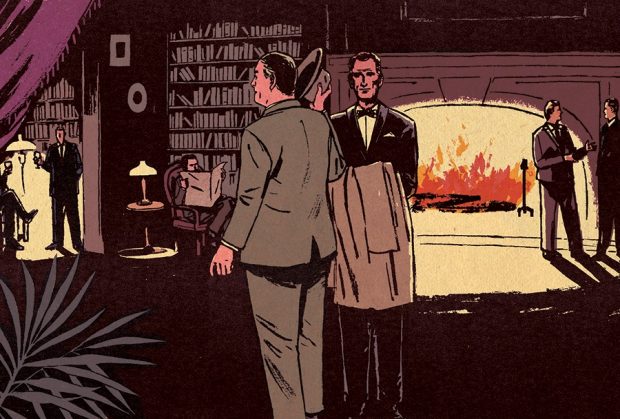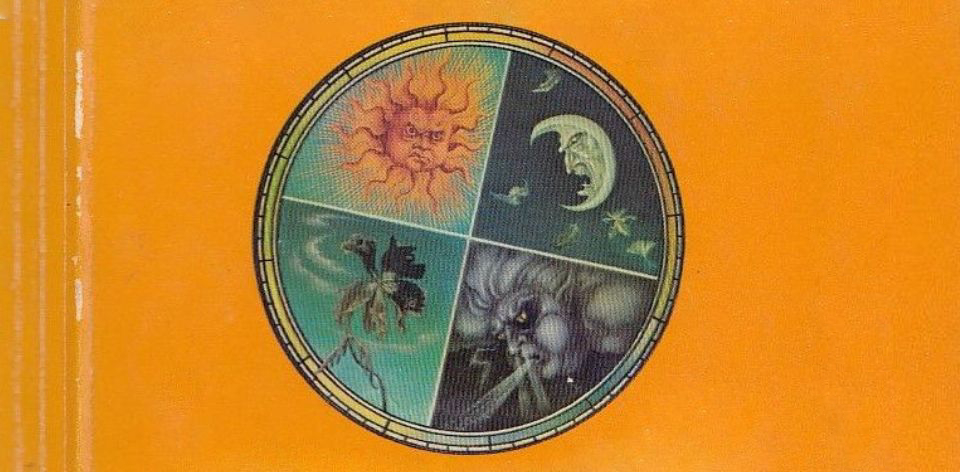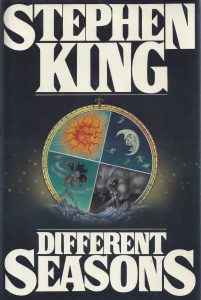Welcome to the feature column that explores a decent number of Stephen King’s books in the order they were published! (More or less!) Fair warning: there will be spoilers ahead.
We’re currently in the golden age of Stephen King film and television adaptations. While most of these tend to be his iconic horror books, DIFFERENT SEASONS is arguably distinct for having the most famous King films that people don’t immediately associate with the writer. To start with, there’s very little horror – although there are a few deaths.
Originally published in 1982, the book consists of four previously written stories that King couldn’t find homes for, citing their unusual length as the reason they were never submitted. “25,000 to 35,000 words are numbers apt to make even the most stout-heard writer of fiction shake and shiver in his boots,” he explains in the volume’s afterword. Too long for short stories, too short for novels, King uses seasonal subtitles to thematically link his novellas under one umbrella.
The book’s opener, Rita Hayworth and Shawshank Redemption (subtitled Hope Springs Eternal) is perhaps the most well known of the crop, thanks largely to its Academy Award nominated adaptation in 1994. It needs little introduction, being the tale of the falsely accused Andy Dufresne, how he came to be locked up, and the circumstances of his liberation. It’s related to us by Red, a “man who knows how to get things” on the inside.
The last time I read the story I was more than likely in my mid-to-late-teens and as excited by the film as the next person. In the 20-something years since that fateful first foray, the story hasn’t aged a day. Even filtered through several viewings of the film – which, although excellent, leans heavily into melodrama – the novella remains one of King’s most powerful statements on the enduring nature of hope. After all, this is the story that gave us the phrase that launched a thousand inspirational tattoos, posters, and social media posts: “Get busy living or get busy dying.”

Which makes Apt Pupil (Summer of Corruption) even more cutting by its immediate juxtaposition. The only story in the collection that isn’t told in the first person, it concerns Todd: a star pupil fascinated with his Nazi war criminal neighbour Kurt Dussander. As the two spend more time together, their relationships takes a darker turn. They vie for the upper hand, and turn their frustrations outward in violent ways: Todd into a nightmarish descent into killing the homeless, while Dussander runs his own murder fest in his basement. It’s actually a nasty little affair, closer in tone to the Richard Bachman books, although there’s an overt reference to Springheel Jack, thus recalling the “Strawberry Spring” short in Night Shift.
Then there’s The Body (Fall From Innocence), or as it will forever be known to most: Stand By Me. When I first read the story, I’d already seen the film, but as an impressionable lad in his mid-teens, there was an appeal to this boys’ own adventure. To suggest that this isn’t like King’s other work would miss all the crucial touchstones: it’s a writer reflecting back on his formative years, and the crossing of a threshold from which one can never return. There’s as much King in this as there is in On Writing. In fact, at least one of narrator Gordon Lachance’s short stories – interspersed throughout the novella – was said to be published in Cavalier magazine, King’s outlet of choice throughout the 1970s.

The Breathing Method (A Winter’s Tale) is the most unique of the bunch, ironically because it is the closest thing to a horror story. Picking up on King’s love of Lovecraft, this is the Christmas story I always wanted. David is a Manhattan lawyer who joins a men’s club that likes to tell tales, especially those that tend towards the strange. The framing device gives way to a story set in the 1930s, about a young doctor who teaches a single mother the (then) radical Lamaze method. That this story winds up with a decapitation, a still breathing head, and live birth is all part of the genius of one of King’s most Gothic outings since ‘Salem’s Lot.
Yet it was actually The Body that was written immediately after ‘Salem’s Lot. In the afterword, King makes a point of telling us each of these novellas followed the completion of another novel: Shawshank followed The Dead Zone, The Breathing Method followed Firestarter, and Apt Pupil right after The Shining. It might explain some of the connections to that work: Dussander not only references Andy Dufresne from his companion tale, but one character mentions he is staying in “Room 217.” Some have speculated that Apt Pupil is actually the play Jack Torrance was working on, given that Torrance is said to be writing a character named Denker (which is Dussander’s alter ego).
In fact, DIFFERENT SEASONS is filled to the brim with connections to other King stories, from Cujo to Carrie and the (then) yet-to-be-published It. The metatextuality is something they all have in common, especially given that each novella is about a storyteller of sorts. “You were writing about Andy Dufresne,” acknowledges Red in Shawshank. “You’re nothing but a minor character in your own story.” Gordie not only tells the overall story of The Body, but several “published” stories within stories. Dussander relates his war stories to Todd, who also concocts the fabrication that he is reading to his new ‘friend.’ The Breathing Method is entirely about the telling of tales.
DIFFERENT SEASONS may have been an oddity upon release, but it paved the way for a very different series of King stories. Following The Shawshank Redemption, director Frank Darabont adapted King’s other prison tale, The Green Mile, originally released as a serial novel in 1996. (It was Bryan Singer who adapted the story about an illicit relationship between a young boy and a much older man, and let’s just leave that thought right there). Novellas like Gwendy’s Button Box and Elevation regular pepper King’s output as standalone releases.
In fact, there’s a good argument to be made that DIFFERENT SEASONS is one of the most culturally influential pieces of writing of his career. As at 2019, The Shawshank Redemption still tops the IMDB Top 250 Drama List. The Body/Stand By Me not only echoed through the narrative of It, but its influences run all the way to Stranger Things. The Breathing Method has been announced for a 2020 release with Scott Derrickson directing. So the next time someone rolls their eyes at you when you are proselytizing Stephen King, slide them your well-worn paperback copy of this tome.
Start your engines, Inconstant Readers. Up next: Christine. (By way of a little adaptation focus on Doctor Sleep and Misery).





